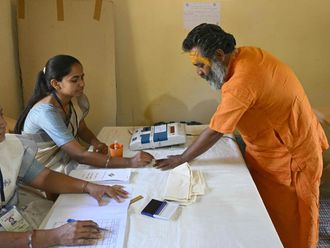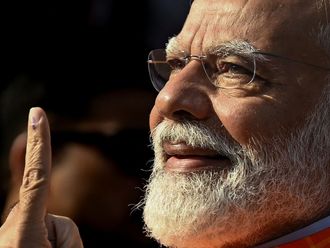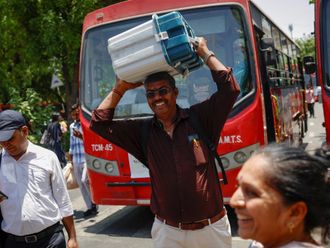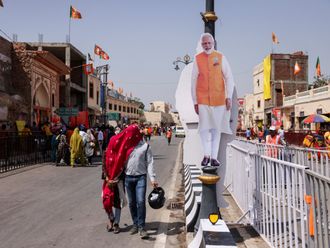
India’s suicide rates constitute a public health crisis, according to a study published in Lancet, the UK medical journal. Nearly two in every five women in the world who kill themselves are Indian, according to the study.
We look at possible reasons of these high rates of suicides in the country, several case studies of suicides in India and expert views on this growing epidemic.
Though the rate of Indian women who die by suicide has fallen since 1990, the decline in numbers is not as fast as elsewhere in the world, and now represents 36.6 per cent of global female suicide deaths, the report found.
The suicide rate among Indian women was three times higher than what might be predicted for a country with similar geography and socio-economic indicators, the researchers said.
She and other specialists blamed the trend on early marriage - one-fifth of Indian women still marry before the age of 15 - along with male violence against women and other symptoms of a deeply entrenched patriarchal culture .
They do not welcome even an independent working daughter home, if she is in an unhappy marriage. Separation from husband means enduring accusations of destroying the family harmony. A financially dependent daughter, with children, suffers even more, as neither her father, nor brothers are willing to take her responsibility.”
What drives these women to suicide?
Patriarchy
One of the many factors is the regressive and patriarchal social and cultural norms in the country. Patriarchy began experiencing some of its first challenges in the 1980s. The patriarchal barriers were broken and as women gained education, some of them nurtured dreams of having a career and becoming independent. These educated young women began questioning societal norms and demanded respect and representation in family decisions.
Rooted hierarchies were disturbed and women who refused to compromise underwent great mental stress. Along with it, the marriage set-up left no space for them to pursue their ambitions. Torn between the burden of societal expectations, economic dependence and in some cases early marriage and motherhood, left them with no respite. Few became first suicide victims of rising aspirations. Women, who were separated, divorced or victims of domestic violence, found no solace or protection from society, law or parental home.
Early marriage
About 27 per cent girls are still married off before they turn 18. This leads to early pregnancy, dropping out of education system and being prone to violence from their male partners. Because of early motherhood, a girl goes through tremendous emotional and physical pressures, which often lead to depression and in some cases; the person loses the desire to live.
As an early marriage forces a girl to drop out of school, she is unable to attain formal education, thereby losing the prospects of acquiring skills and jobs, leading to lack of financial independence. Having to take up several responsibilities at a tender age, she finds it difficult to cope up with situations. Importantly, even educated women lack control of several family decisions, including when and the number of children they want to have, and are victims of domestic violence and sexual harassment.
Factors like dowry demands and morbidity add to their woes.
Economic ambitions
The 1980s was a time when rising economic ambitions allowed the evil of dowry system to spread in society and young girls became potent victims of this practice. Fed up of continuous physical and verbal abuse and unable to return to their parental home compelled them to take their lives.
Data reveals that maximum suicides by women continue to be committed in the age group of 15 to 39 years. For, daughters are given a ceremonial send-off by parents at the time of their marriage with a message, ‘not to return home until death.’
Dual stress
Another factor that drives women to suicide is dual stress, both, at work place and home, added with sexual exploitation at either or both spaces. Having dreams and aspirations, but no spousal support, they find themselves trapped in difficult system and social milieu. There has been a spike in such cases in the recent past. Lack of awareness and mental health facilities and the stigma attached to meeting marriage counselors or psychiatrists have been major concerns and are also prime reasons for women committing suicide.
These issues have not only become worse over the years, the culture of silence has aggravated it.
What do the numbers say?
Spousal violence
The National Family Health Survey 2015-16 revealed that 30 per cent of married women in India experience spousal violence and 3.3 per cent married women experience violence during pregnancy with wide variation across states. Violence affects the mental health status of women and results in concerns such as post-traumatic stress disorder, anxiety, depression and eating disorder – all of which can contribute to suicidal tendencies.
“The fact that only 11 per cent women admitted to being harassed and only 3 per cent admitted they suffered non-consensual sexual touch (International Institute of Population Sciences and Population Council, 2010), demonstrates how cases of violence against women are under-reported.”
Dr Chandramaniya says, “India’s overall part in global suicide deaths increased from 25.3 per cent in 1990 to 36.6 per cent in 2016. The suicide rate by women in the country is currently 16.4 per 100,000, making it the sixth highest number in the world.”
Why is this problem not a priority?
As the country struggles with other problems like malnutrition and infant and maternal mortality, suicide prevention has ranked lowest in its priority, say experts. It is only recently that under the Mental Health Act 2017, suicide was de-criminalised. It’s time families and communities came in support of women and prevented them from committing suicide.
What needs to be done?
“First of all, we have to introduce necessary changes in our mental health care system and train current and new health care providers,” says Dr Vinesh D Chandramaniya.
“We have to educate and collaborate with the media to spread awareness and try limiting access to methods of suicide. The social support networks must also be strengthened. There is also a need to create a healthy and safe environment for women, addressing their needs properly and effectively, listening to their issues, providing proper sex education at primary and middle school levels to prevent sexual abuse. There is a gradual increase in awareness through efforts of mental health and psychiatric associations at the individual, state and national levels. Social media is also playing a slow yet steady and positive role in creating awareness about mental health, particularly that of women.”
Compiled by Malavika Kamaraju, Features Editor
CASE STUDIES
“Our daughter was an independent and strong woman. She could never have taken her life.”
Sangeeta, 28, died two months ago. What pushed her to suicide?
“We wish we had not forced Sangeeta to go back to her in-laws. Sangeeta and her husband worked together in a private company in Noida, that is about 25 kilometres southeast of New Delhi. They were friends for over seven years. The boy’s parents were against the marriage, as it was an inter-caste match (they are natives of Rajasthan and we belong to Uttar Pradesh). But Sangeeta was adamant she would marry only when his parents agreed. Early this year, the boy’s parents finally agreed and in February the two got married. As dowry, we gave our son-in-law all household essentials and we were happy that our daughter had finally settled down. But after 15 days of marriage, when Sangeeta came visiting, she refused to go back to her husband’s home. Believing her to be homesick, we let her be. Never in our wildest imagination did we think that there was anything wrong in her marriage; after all, she had known her husband for seven years. Eventually, she did go back, only to return again. Then in July, her husband insisted she accompany him home. Five days later, we received a call from her in-laws that our daughter had committed suicide. Our daughter was an independent and strong woman. She could never have taken her life. They must have killed her. She continued to work even after marriage. What led to her death, we will never know. She never confided in us about her troubles, perhaps thinking it would disturb us.”
“I saw a stool and a scarf hanging from the fan.”
Pooja and Satya Pal, parents of Ruby, 25, tell Gulf News how they rescued their daughter from a toxic marriage. Prakash is a government official.
“I am glad my daughter is well-educated and working now. When she was 19, elders in my family insisted we get her married. Even though I am a quite progressive, I did not resist the pressure to get her married so early in life. The boy’s horoscope was a perfect match with my daughter’s. He worked in a well-known private firm and lived independently. All went well for two years, until Ruby’s husband began distancing himself from her. He blamed it on work pressure, saying he had to travel to [the state of] Himachal Pradesh often on work. This led to friction between them and my daughter, who contued to work after marriage, soon began to sense that there was more to her husband’s frequent travels than work. She soon discovered he had been over-staying in Himachal as he was in a relationship with another woman. This led to a confrontation and many fights ensued. One day, when she returned home early from work, she was horrified to find her husband with that girl in the house. Caught red-handed, the two hurriedly left the house. It was sheer coincidence that that I decided to drop in that same evening and found my daughter sobbing and distraught, and inside the house, I found a noose fashioned from her scarf hanging by the fan and a stool placed under it. We hugged each other and cried uncontrollably. I did not question her but just helped her pack her bags and brought her home.”
With her parents support, Ruby got a divorce.
(With inputs from Guardian)












